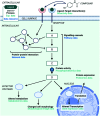Computational analyses of mechanism of action (MoA): data, methods and integration
- PMID: 35360890
- PMCID: PMC8827085
- DOI: 10.1039/d1cb00069a
Computational analyses of mechanism of action (MoA): data, methods and integration
Abstract
The elucidation of a compound's Mechanism of Action (MoA) is a challenging task in the drug discovery process, but it is important in order to rationalise phenotypic findings and to anticipate potential side-effects. Bioinformatic approaches, advances in machine learning techniques and the increasing deposition of high-throughput data in public databases have significantly contributed to recent advances in the field, but it is not straightforward to decide which data and methods are most suitable to use in a given case. In this review, we focus on these methods and data and their applications in generating MoA hypotheses for subsequent experimental validation. We discuss compound-specific data such as -omics, cell morphology and bioactivity data, as well as commonly used supplementary prior knowledge such as network and pathway data, and provide information on databases where this data can be accessed. In terms of methodologies, we discuss both well-established methods (connectivity mapping, pathway enrichment) as well as more developing methods (neural networks and multi-omics integration). Finally, we review case studies where the MoA of a compound was successfully suggested from computational analysis by incorporating multiple data modalities and/or methodologies. Our aim for this review is to provide researchers with insights into the benefits and drawbacks of both the data and methods in terms of level of understanding, biases and interpretation - and to highlight future avenues of investigation which we foresee will improve the field of MoA elucidation, including greater public access to -omics data and methodologies which are capable of data integration.
This journal is © The Royal Society of Chemistry.
Conflict of interest statement
There are no conflicts to declare.
Figures









Similar articles
-
Drug Mechanism: A bioinformatic update.Biochem Pharmacol. 2024 Oct;228:116078. doi: 10.1016/j.bcp.2024.116078. Epub 2024 Feb 23. Biochem Pharmacol. 2024. PMID: 38402909 Review.
-
Translational Metabolomics of Head Injury: Exploring Dysfunctional Cerebral Metabolism with Ex Vivo NMR Spectroscopy-Based Metabolite Quantification.In: Kobeissy FH, editor. Brain Neurotrauma: Molecular, Neuropsychological, and Rehabilitation Aspects. Boca Raton (FL): CRC Press/Taylor & Francis; 2015. Chapter 25. In: Kobeissy FH, editor. Brain Neurotrauma: Molecular, Neuropsychological, and Rehabilitation Aspects. Boca Raton (FL): CRC Press/Taylor & Francis; 2015. Chapter 25. PMID: 26269925 Free Books & Documents. Review.
-
Network-based multi-omics integrative analysis methods in drug discovery: a systematic review.BioData Min. 2025 Mar 28;18(1):27. doi: 10.1186/s13040-025-00442-z. BioData Min. 2025. PMID: 40155979 Free PMC article. Review.
-
Metabolomics and Multi-Omics Integration: A Survey of Computational Methods and Resources.Metabolites. 2020 May 15;10(5):202. doi: 10.3390/metabo10050202. Metabolites. 2020. PMID: 32429287 Free PMC article. Review.
-
Folic acid supplementation and malaria susceptibility and severity among people taking antifolate antimalarial drugs in endemic areas.Cochrane Database Syst Rev. 2022 Feb 1;2(2022):CD014217. doi: 10.1002/14651858.CD014217. Cochrane Database Syst Rev. 2022. PMID: 36321557 Free PMC article.
Cited by
-
Elucidating gene expression patterns across multiple biological contexts through a large-scale investigation of transcriptomic datasets.BMC Bioinformatics. 2022 Jun 15;23(1):231. doi: 10.1186/s12859-022-04765-0. BMC Bioinformatics. 2022. PMID: 35705903 Free PMC article.
-
Using Transcriptomics and Cell Morphology Data in Drug Discovery: The Long Road to Practice.ACS Med Chem Lett. 2023 Mar 22;14(4):386-395. doi: 10.1021/acsmedchemlett.3c00015. eCollection 2023 Apr 13. ACS Med Chem Lett. 2023. PMID: 37077392 Free PMC article. Review.
-
A Decade in a Systematic Review: The Evolution and Impact of Cell Painting.bioRxiv [Preprint]. 2024 May 7:2024.05.04.592531. doi: 10.1101/2024.05.04.592531. bioRxiv. 2024. PMID: 38766203 Free PMC article. Preprint.
-
A genome-scale deep learning model to predict gene expression changes of genetic perturbations from multiplex biological networks.Brief Bioinform. 2024 Jul 25;25(5):bbae433. doi: 10.1093/bib/bbae433. Brief Bioinform. 2024. PMID: 39226889 Free PMC article.
-
Cell Morphological Profiling Enables High-Throughput Screening for PROteolysis TArgeting Chimera (PROTAC) Phenotypic Signature.ACS Chem Biol. 2022 Jul 15;17(7):1733-1744. doi: 10.1021/acschembio.2c00076. Epub 2022 Jul 6. ACS Chem Biol. 2022. PMID: 35793809 Free PMC article.
References
-
- Liggi S. Drakakis G. Koutsoukas A. Cortes–Ciriano I. Martínez–Alonso P. Malliavin T. E. Velazquez-Campoy A. Brewerton S. C. Bodkin M. J. Evans D. A. Glen R. C. Carrodeguas J. A. Bender A. Extending in silico mechanism-of-action analysis by annotating targets with pathways: application to cellular cytotoxicity readouts. Future Med. Chem. 2014;6:2029–2056. doi: 10.4155/fmc.14.137. - DOI - PubMed
-
- Page S. W. and Maddison J. E., in Small Animal Clinical Pharmacology, ed. J. E. Maddison, S. W. Page and D. B. Church, W. B. Saunders, Edinburgh, 2nd edn, 2008, pp. 1–26
-
- Mechanism matters, Nat. Med., 2010, 16, 347. - PubMed
-
- Rovin L., 22 Case Studies Where Phase 2 and Phase 3 Trials Had Divergent Results, FDA
Publication types
Grants and funding
LinkOut - more resources
Full Text Sources

